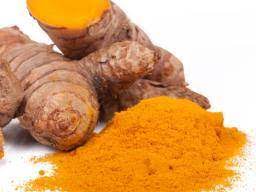 Turmeric is a flowering plant, Curcuma longa, of the ginger family.
Turmeric is a flowering plant, Curcuma longa, of the ginger family.
Its rhizomes of which are used in cooking.
The plant is a perennial, rhizomatous, herbaceous plant native to the Indian subcontinent and Southeast Asia.
The rhizomes are used fresh or boiled in water and dried, then ground into a deep orange-yellow powder commonly used as a coloring and flavoring agent in many Asian cuisines, especially for curries, as well as for dyeing, characteristics imparted by the principal turmeric constituent, curcumin.
Turmeric powder has a warm, bitter, black pepper-like flavor and earthy, mustard-like aroma.
Curcumin, is a bright yellow chemical produced by the turmeric plant, is a food additive
There is no quality clinical evidence that consuming turmeric or curcumin is effective for treating any disease.
Potential health benefits associated with turmeric:
Anti-inflammatory properties: Curcumin has known anti-inflammatory effects, which may help reduce inflammation in the body.
Chronic inflammation is believed to be a contributing factor to various chronic conditions, such as heart disease, diabetes, and certain cancers.
Antioxidant activity: Turmeric has strong antioxidant properties, which can help protect our cells against damage caused by free radicals.
Antioxidants can potentially reduce the risk of chronic diseases and support overall health.
Improved brain function: There is some evidence to suggest that curcumin may enhance brain health.
It has been linked to boosting brain-derived neurotrophic factor (BDNF), a growth hormone that helps promote the growth of new neurons and may improve cognitive function.
Digestive health: Turmeric has traditionally been used to support digestive health.
It is believed to aid in digestion and potentially reduce symptoms of conditions like indigestion, bloating, and gastrointestinal disorders.
Potential anti-cancer properties: Some studies have shown that curcumin may have anti-cancer effects by inhibiting the growth of cancer cells, reducing angiogenesis (the formation of new blood vessels), and inducing apoptosis (cell death) in cancer cells.
Joint health: The anti-inflammatory properties of curcumin may help reduce pain and inflammation in conditions such as arthritis
Turmeric is a perennial herbaceous plant that reaches up to 1 m tall.
It has highly branched, yellow to orange, cylindrical, aromatic rhizomes.
Turmeric powder is about 60–70% carbohydrates, 6–13% water, 6–8% protein, 5–10% fat, 3–7% dietary minerals, 3–7% essential oils, 2–7% dietary fiber, and 1–6% curcuminoids.
The golden yellow color of turmeric is due to curcumin.
Phytochemical components of turmeric include numerous curcuminoids, such as curcumin.
Curcumin constitutes up to 3.14% of commercial samples of turmeric powder, and curry powder contains much less at an average of 0.29%.
Some 34 essential oils are present in turmeric.
Turmeric is one of the key ingredients in many Asian and Middle Eastern dishes.
It adds a mustard-like, earthy aroma and pungent, slightly bitter flavor to foods.
Most turmeric is used in the form of rhizome powder to impart a golden yellow color.
It is a principal ingredient in curry powders.
Turmeric is approved for use as a food color.
Turmeric herbal teas could be used to relieve mild digestive problems, such as feelings of fullness and flatulence.
Turmeric grows wild in the forests of South and Southeast Asia.
It is used in chemical analysis as an indicator for acidity and alkalinity.
There is no scientific evidence that curcumin reduces inflammation;
There is weak evidence that turmeric extracts may be beneficial for relieving symptoms of knee osteoarthritis, as well as for reducing pain and muscle damage following physical exercise.
